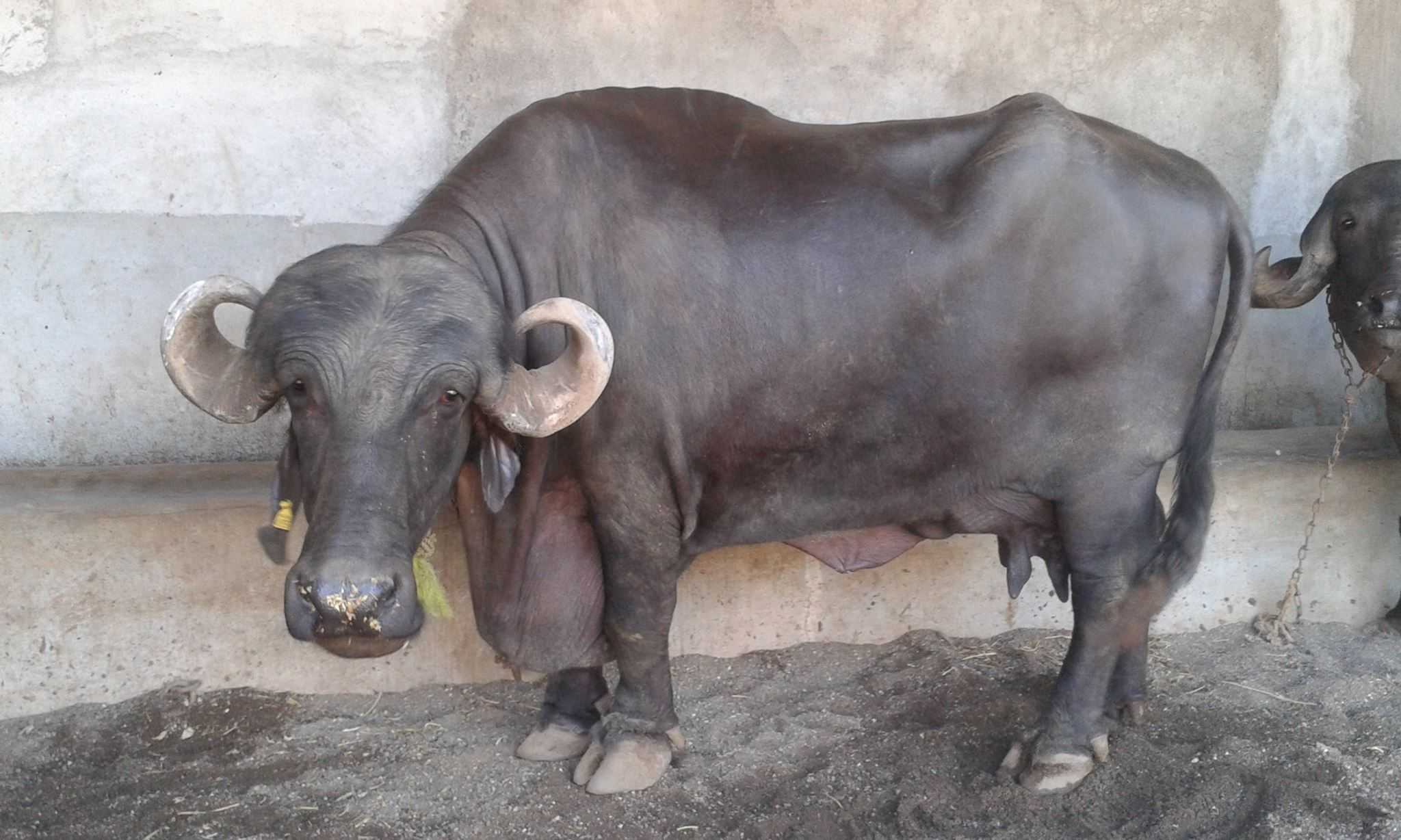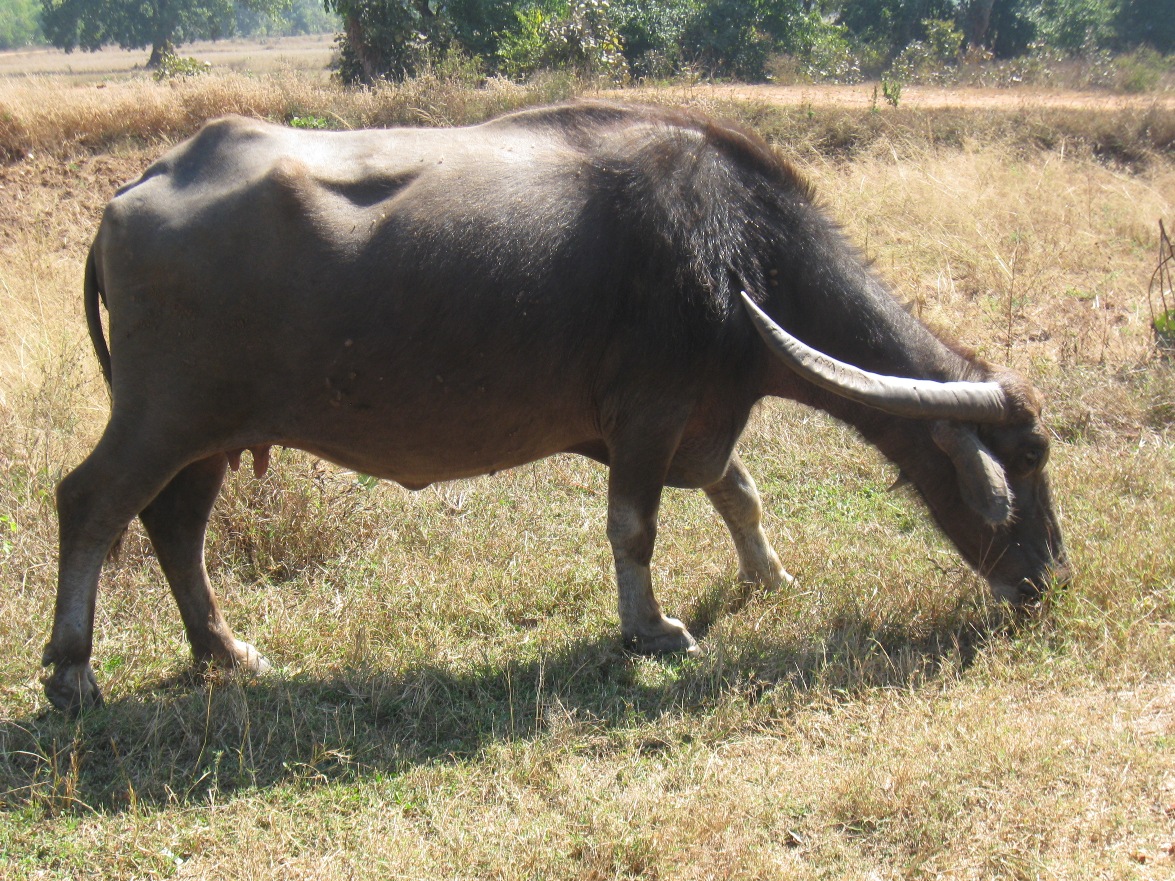
Livestock: BUFFALO
Buffalo Farming
The domestic water buffalo Bubalus bubalis, belongs to the family Bovidae, sub-family Bovinae, genus bubalis and species arni or wild Indian buffalo. Buffalo are classified into two distinct classes: swamp buffalo and river buffalo. The swamp type is most common in Southeast Asia where it is mostly employed as a draught animal. It has derived its name from the natural habitat which is swamp or marshland. Swamp buffaloes resemble the wild arni in morphological characteristics. Swamp buffaloes have a very low milk yield and are not used as milk producers. The river buffalo is the most common type in India, Pakistan, Bulgaria, Hungary, Turkey, Italy, Egypt, and Brazil. They are massive in size mostly with curled horns, prefers to wallow in clean water and rivers, thereby the name. River buffaloes have been selected for milk production to a larger extent.
SIGNIFICANCE OF BUFFALO FARMING
Livestock forms an integral part of agriculture in India and involves the participation of around 70% of its population, most of which are small or medium-scale holders. Buffalo farming is an important component of the livestock industry and contributes more than 50 million tons of milk and 1.43 million tons of meat in addition to high valued hides, bones and draft power for agricultural operations. Buffaloes in India are spread over almost all parts of the country with varying density of population in different states and union territories. The majority of the population is reared in the north and western states where most of the milch breeds of buffaloes are found. It is interesting to note that, the share of buffaloes in the overall bovine numbers in the country has also steadily gone up since independence, and more than 56% of the milk that Indians consume is from buffaloes.
Buffalo farming is an important component of our rural economy and apart from milk production; they are also valued for meat and draught purposes. Buffalo milk also fetches higher price, as it contains 7-7.5% fat, almost twice that from cows. Buffaloes are more efficient converters of low-quality feeds or coarse fodder. They require a relatively low level of inputs in the predominantly mixed farming systems, and are well known for their ability to thrive on low-quality crop residues and green forage under harsh climatic conditions. India has been regarded as an extremely rich gold mine of buffalo germplasm resources as it harbours all the recognized, high producing breeds of this species. Indian dairy industry is undergoing transformational change and buffalo sector has an important contribution in overall milk production as it alone contributes to 66.3% of total volume of buffalo milk in the world. With Indian buffaloes accounts for nearly 56% of the world's buffalo population, about 25% of world buffalo meat is produced in India and racked up meat exports worth Rs 26,685.44 crore in 2015-16 and thus plays a key role in the national economy. Buffalo farming has become a livelihood and resource generating enterprise for varied strata of our farmers. It is playing a major role in alleviation of poverty and the commercial buffalo enterprises now provide employment to rural communities.
I. IMPORTANT BREEDS OF BUFFALO
India has been regarded as an extremely rich region of buffalo germplasm resources as it harbours all the recognized, high producing breeds of this species. There are about 10 indigenous standard breeds of buffaloes, which are well known for their milking qualities. The best known breeds are Murrah, Nili-Ravi, Jaffarabadi, Surti, Mehsana and Bhadawari. Important breeds of buffaloes and their characteristics are briefed below:
Murrah
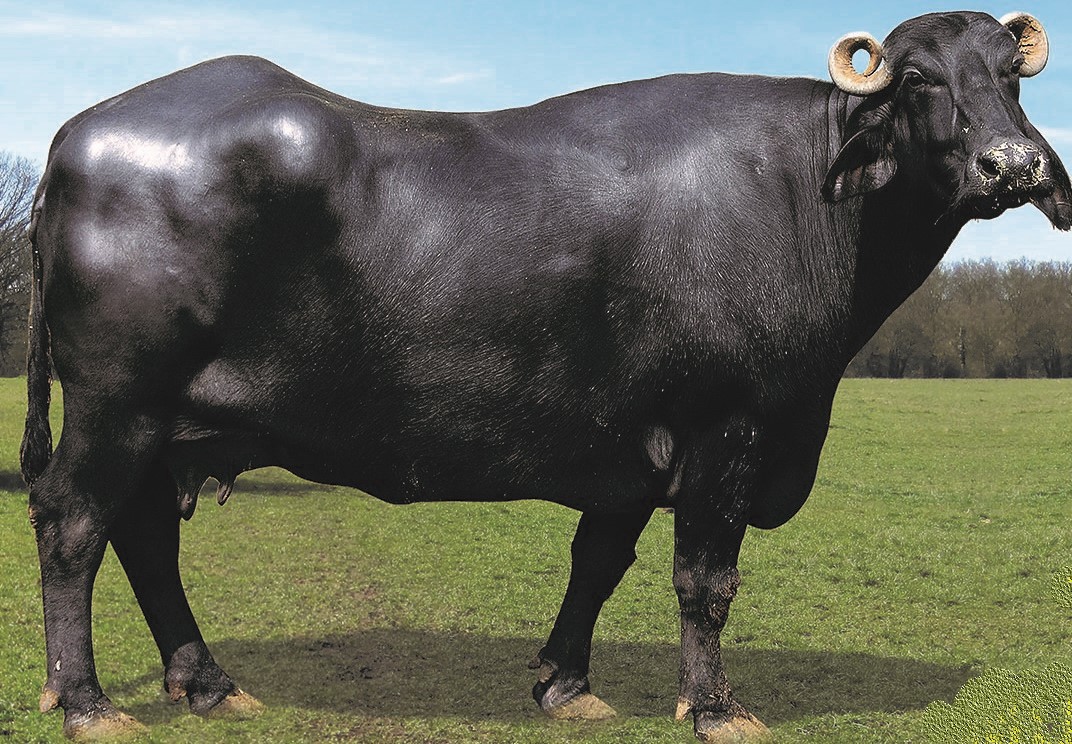
* It is the most important milch breed of buffaloes whose home tracts are Rohtak, Hisar and Jind of Haryana and Nabha and Patiala districts of Punjab.
* Murrah is good milk producer in the world and the bulls of this breed are extensively used to upgrade the non-descript buffalo stock.
* Skin colour is usually jet black with white markings on tail and face and extremities sometimes found. Tightly curved horn is an important character. Body is sound built, heavy and wedge shaped in appearance.
* They are one of the most efficient milk and butter fat producers in India. Fat content is around 7% while average lactation yield is 1752 kg. Age at first calving is 36-45 months and inter-calving period is 450-500 days.
Surti

* Breeding tract is Kaira and Baroda districts in South Western Gujarat. Coat colour varies from rusty brown to silver-grey. The body is well shaped and medium sized; the barrel is wedge shaped. The horns are sickle shaped, moderately long and flat.
* The milk yield ranges from 900 to 1300 kg. The age at first calving is 40-56 months with an inter-calving period of 400-535 days. The peculiarity of this breed is high fat percentage in milk (8-12%).
Jaffarabadi

* These are massive animals found in their pure form in Gir forests. Breeding tract of is Kutch, and Jamnagar districts of Gujarat. Forehead is very prominent, wide with a slight depression in the middle. Horns are heavy, inclined to droop at each side of the neck and then turning up at point compressing head, but less tightly curved than in Murrah (drooping horns).
* These animals are mostly maintained by traditional breeders called Maldharis, who are nomads. The bullocks are heavy and used for ploughing and carting. Average age at first calving is 45 months and average lactation milk yield is 2239 kg.
Mehsana
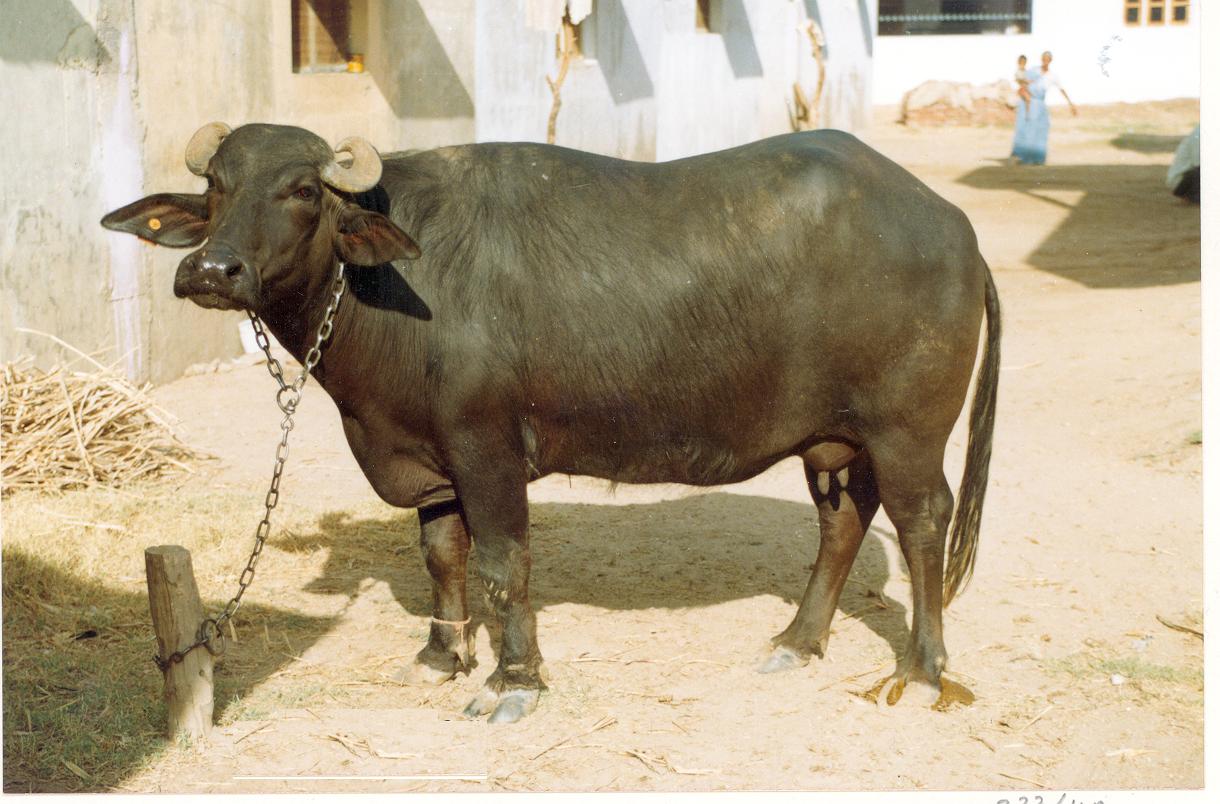
* Mehsana is a dairy breed of buffalo found in Mehsana region in Gujarat and adjoining Maharashtra state. Body is mostly black; a few animals are black-brown in colour.
* Forehead is wide with slight depression in middle, horns usually are slightly curved at the end and inward compared to Murrah but are longer and could be of irregular shape.
* The inter-calving period ranges between 450-550 days. Age at first calving is around 40-45 months. Average lactation milk yield is 1988 kg and milk fat is 6.83%.
Pandharpuri

* Native of Kolhapur, Solapur districts in southern Maharashtra.
* Body colour varies from light blackish with grey to deep black. It is medium sized animal having long narrow face, very prominent and straight nasal bone, comparatively narrow frontal bone and long compact body.
* Horns which are very long, curved backward, upward and usually twisted outwards and touching hock bone. They have favourable reproductive capacity with almost one calf per year.
· Average age at first calving is 44 months and calving interval is around 13.6 months. Average lactation milk yield is 1790 kg.
Chilika
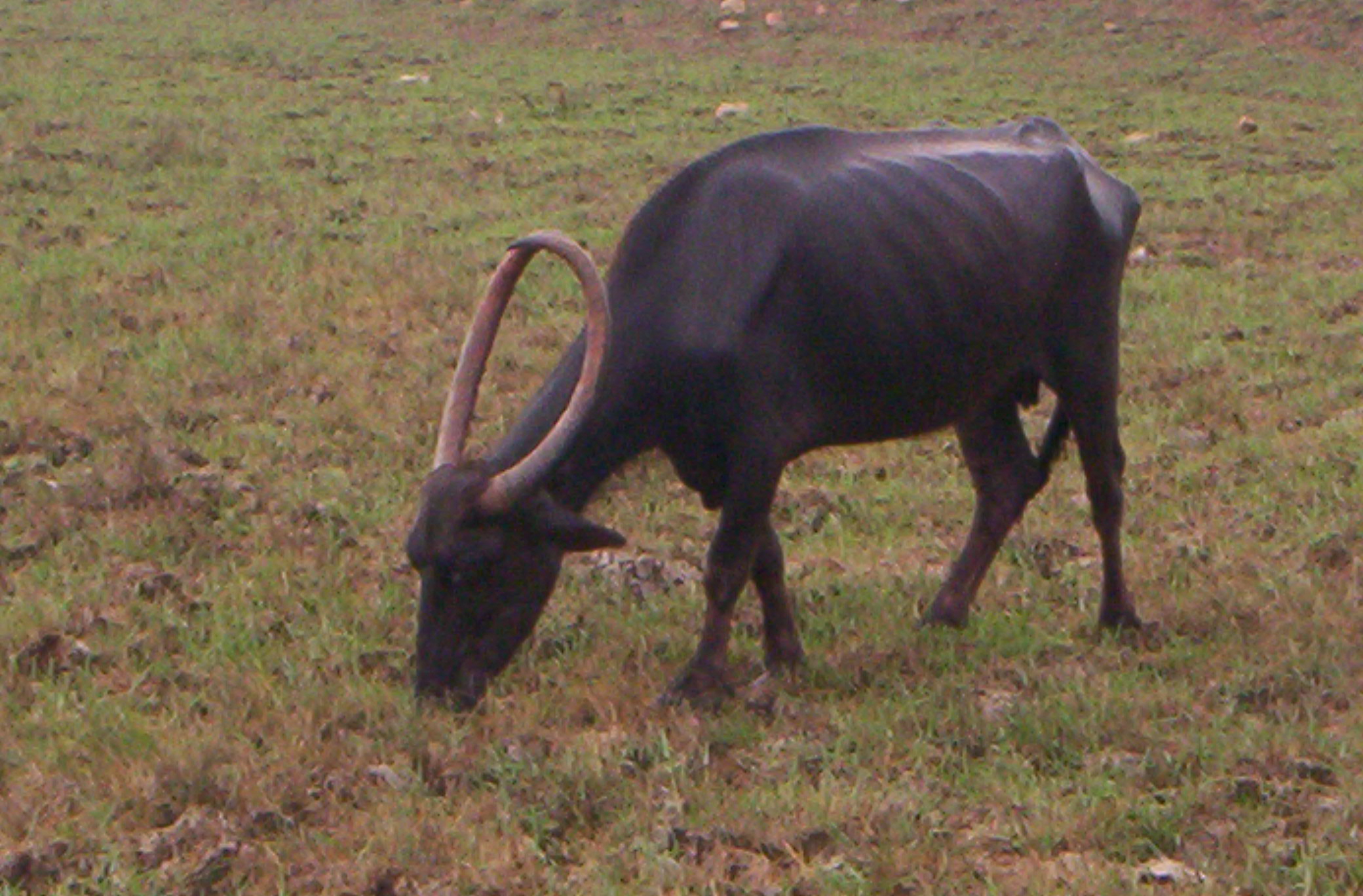
* Native of areas around the brackish water lagoon, Chilika lake spread over Puri, Khurda and Ganjam districts of Orissa.
* These animals are endowed with the special capability of entering deep into the lake and feeding on the vegetation that grows in saline and coastal conditions.
* Average lactation milk yield is 500 kg with an average milk fat of 8.7%.
Toda
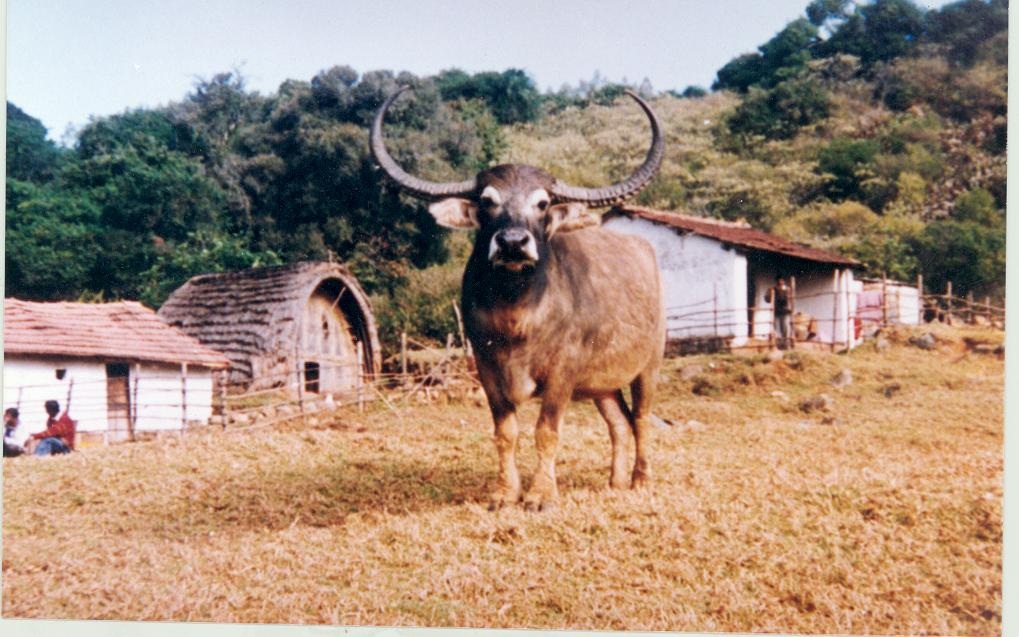
* Toda breed of buffaloes is named after an ancient tribe, Toda of Nilgiris of south India and are quite distinct from other breeds and are indigenous to Nilgiri hills.
* Coat colour of the calf is generally fawn at birth. The animals have long body, deep and broad chest, and short and strong legs. The head is heavy with horns set well apart, curving inward outward and forward. Thick hair coat is found all over the body.
* Average age at first calving is 48 months and calving interval ranges from 14 to 18 months. Average lactation milk yield is 500 kg with 8.2% milk fat.
Bhadawari
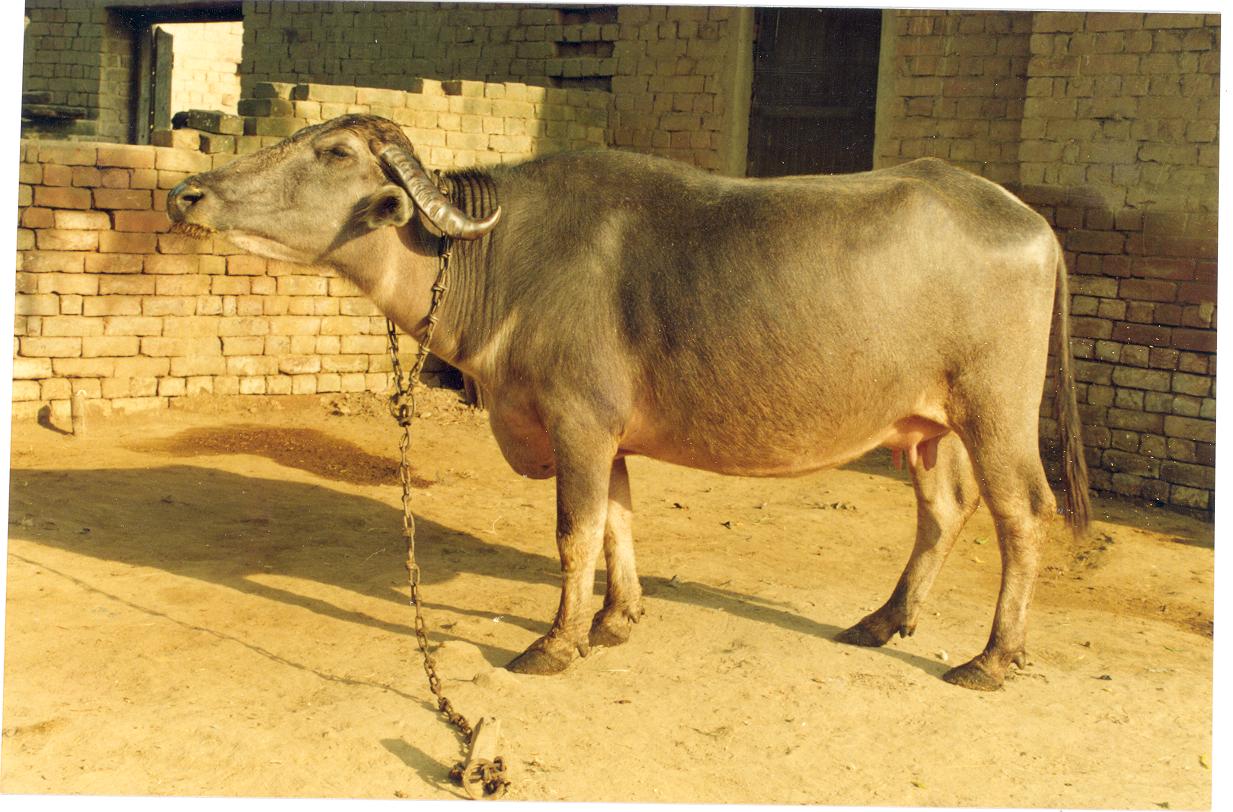
* This breed is common in Agra, Etawah and Gwalior districts. body is medium size and wedge shaped. The head is comparatively small, the legs are short and stout, and the hooves are black.
* The body is usually light or copper coloured is a peculiarity of this breed. Two white lines ‘Chevron*are present at the lower side of the neck similar to that of Surti breed.
* This breed is an efficient converter of coarse feed into butterfat and is known for its high butter fat content. Average lactation milk yield is 1294 kg. The fat content varies from 6 to 12.8%.
Kalahandi
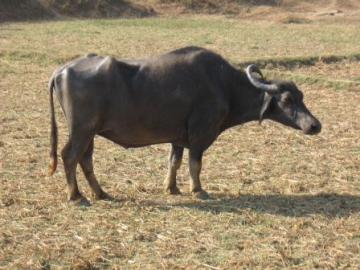
* This breed is native to whole Gajapati district and a part of Ganjam and Rayagada district in Orissa, besides adjoining hilly regions of Andhra Pradesh. Coat colour of these animals ranges from black to blackish grey.
* They have flat foreheads with golden hairs on it. Besides the use of this buffalo for milk and draft purpose, horns are used in making handicrafts and house hold items, which adds to the economic utility.
* They are moderate milk yielders with lactation yield ranging from 680 to 912 kg.
II. HOUSING MANAGEMENT IN BUFFALOES
Successful management of buffalo rearing will be incomplete without well-planned and adequate housing facilities. Improper planning in the arrangement of animal housing may result in management problems, increase in disease incidence, additional labour charges and that decrease the profit of the farmer. During erection of a house for dairy buffaloes, care should be taken to provide comfortable accommodation for some individual animal. No less important is the (1) proper sanitation, (2) durability, (3) abundant supply of clean water (4) arrangements for the production of clean milk under convenient and economic conditions. Buffaloes may be successfully housed under a wide variety of conditions, ranging from close confinement to little restrictions except at milking time. However, two types of farms are in general use.
1. Loose housing barn in combination with some type of milking barn or parlor: Loose housing may be defined as a system where animals are kept loose except milking and at the time of treatment. The system is most economical. Some features include:
-
Construction expense is significantly lower than conventional type sheds.
-
Facilitate easy detection of animal in heat or estrus.
-
Animals feel free and therefore, proves more profitable with even minimum grazing
-
Animals get optimum exercise which is extremely important for better health production.
2. The conventional buffalo shed: The conventional barns mainly in intensive system of rearing consist of different sheds for different classes of animals and are comparatively costly. By this system animals are more protected from adverse climatic condition. The sheds which are generally needed for proper housing of different classes include cow sheds, calving box, sheds for young stocks, bull sheds etc.
Some of the important points for overall efficient housing include:
-
Buffalo shed should be at a higher elevation than the surrounding ground to offer a good slope for rainfall and drainage for the wastes of the farm to avoid stagnation within. A leveled area requires less site preparation and thus lesser cost of building. Low lands and depressions should be avoided.
-
Shed should be located to a maximum sunlight exposure in the north and minimum exposure to the sun in the south and protection from prevailing strong wind currents whether hot or cold.
-
Buildings should be placed so that direct sunlight can reach the platforms, gutters and mangers in the buffalo shed. As far as possible, the long axis of the dairy barns should be set in the north-south direction to have the maximum benefit of the sun.
-
Inside floor should be of some impervious material which can be easily kept clean and dry and is not slippery. Paving with bricks or grooved cement concrete floor are good options. The surface of the cowshed should be laid with a gradient of 1" to 1 14" from manger to excreta channel. An overall floor space of 70 to 75 sq. feet per adult animal should be satisfactory.
-
Inside of the walls should have a smooth hard· finish of cement and comers should be round. For plains, dwarf walls about 4 to 5 feet in height and roofs supported by masonry work or iron pillars will be best or more suitable. The open space in between supporting pillars will serve for light and air circulation.
-
Roof of the shed may be of asbestos sheet or tiles. Corrugated iron sheets have the disadvantage of making extreme fluctuations in the inside shed temperature in different seasons. However, iron sheets with aluminium painted tops to reflect sunrays and bottoms provided with wooden insulated ceilings can be of useful.
-
A height of 8 feet at the sides and 15 feet at the ridge will be sufficient to give necessary air space to animals. To make ventilation more effective, continuous ridge ventilation is considered most desirable.
-
Mangers prevent feed wastage and cement concrete continuous manger with removable partitions is the best from the point of view of durability and cleanliness. Low front mangers are more comfortable but high front. The manure gutter should be wide enough to hold all dung without getting blocked, and be easy to clean. Suitable dimensions are 2" width with a cross-fall of 1" away from standing. The gutter should have a gradient of 1" for every 10' length for free flow of liquid excreta. The doors of a single range cowshed should be 5" wide with a height of 7', and for double row shed the width should not be less than 8" to 9'.
III. FEEDING MANAGEMENT IN BUFFALOES
Feeding management is an important factor influencing productivity of the farm and the potential of dairy animal can be fully exploited when they are fed with balanced ration. Buffaloes are, like cattle, ruminants. This means that they utilize micro-organisms in the rumen to digest the feed. The ruminant is an expert in converting cellulose and other fibrous materials into high quality milk. The feed will enter the rumen, an anaerobe environment where no oxygen is present, when swallowed by the animal. The feed is exposed to microbes such as bacteria, protozoa which digest feed particles and by enzymatic action, the components are broken down and used for their own metabolism, growth and propagation. The feed is masticated, regurgitated and exposed to microbes in the rumen. Large particles will become smaller and eventually be transported to the reticulum and further on.
Water is essential for most body functions, such as body temperature control, milk production and maintaining blood plasma volume. Drinking water is the most important water source and should be of good hygienic quality. The water available in feed is highly dependent on the dry matter in feed. Straw, hay and cereals contain little water, whereas silage and fresh grass may contain as much as 70%. Generally, buffaloes require more water than cattle under the same circumstances and should have access to clean cool water and libitum. Besides water, major nutrients in the feed are required by buffaloes in proper amount and proportions for optimum production. The components of the feed can be divided into energy (carbohydrates), protein, fat, minerals and vitamins. All types of nutrients are present in feed ingredients, but in varying proportions.
Carbohydrate: Carbohydrates are the predominant sources of energy. Carbohydrate can be broadly divided into two types i.e. structural (fibrous) carbohydrate and soluble carbohydrate (sugar and starch). Main sources of fibrous carbohydrate are green fodder; while the predominant sources of soluble carbohydrate are cereal grains (maize, rice kani, sorghum etc) and their by-products (rice polish, de-oiled rice polish, wheat bran etc). Starch can be degraded by animal gastric enzymes, whereas fibres cannot. Ruminants can utilize fibres to a larger extent than mono-gastric animals because of the ruminal microbes. It is generally believed that buffaloes utilize fibre more efficiently than cattle do.
Protein: The main functions of protein are to synthesize tissue protein or milk protein. The major sources of vegetable protein are leguminous fodder (cow pea, guara etc), oil seed cakes (soybean meal, groundnut cake, cotton seed cake etc) and some agro industrial by-products (rice polish, de-oiled rice polish, wheat bran etc). As a single protein source is not rich in all the essential amino acids, to get a balance of amino acids for proper protein synthesis, it is always encouraged to feed protein from two or more sources. Protein can also be protected to withstand microbial attack in the digestive system. These protected by-pass protein are only degraded in abomasum and small intestine. By-pass-protein is commercially available in some readymade concentrates and is usually given to high yielding animals.
Fat: It provides around two times more energy than the carbohydrate and protein. Besides, it provides essential fatty acids (fatty acids, which are not synthesized in body but are required by body), makes the diet more palatable and reduces dustiness of the diet. The main sources of fat in the diet are oil seeds (cotton seed, full fat soybean etc), expeller type oil cakes (groundnut cake, cottonseed cake etc) and supplements like by-pass fat (rumen protected fat).
Minerals and Vitamins: There are about seventeen minerals, which are well defined for dairy animals. The minerals are broadly divided into two groups i.e. macro minerals like calcium, phosphorus, sodium, potassium and micro minerals like iron, copper, zinc, manganese, cobalt, iodine. Minerals help in proper utilization of other nutrients, keep animal healthy, increase milk production and reduce infertility. Calcium and phosphorus are required in highest amount in the diet of lactating animals.
Similar to minerals, vitamins also help in proper utilization of other nutrients, keep the animal healthy, increase milk production and reduce infertility. Buffaloes have the ability to synthesize vitamin B complex, vitamin C, vitamin K and vitamin D in their own body; however for Vitamin D, exposure to sun light is required. Thus, only vitamin A and vitamin E are dietary essential for dairy animals. Green fodders are predominant sources of these vitamins. Animals which do not receive a readymade concentrate mixture with mineral and vitamin supplement, must be fed supplement in the form of lick stones or mineral blocks of which the animals have free access to or as powder fed once or twice a day individually.
Feedstuff and nutrient requirements
The balanced ration of dairy animals like buffalo has mainly two components i.e. roughage and concentrate mixture. The roughage part includes both dry roughages and green roughages (fodder). The dry roughages include crop residues like straws and stover (paddy straw, dried karad grass, maize stovers and jowar straw, kadabakutti). Crop residues are very poor in nutritive value and mainly provide bulk to the animal. Green roughages include cultivated fodder crops, road side un-cultivated grasses and tree leaves. Fodder trees include Leucaena leucocephala, Sesbania, Gliricidia etc. with high crude protein content (20-25%). A maximum ratio of 50% tree legumes in total diet can be considered as a safe level. About 25-30 kg good quality green fodder will take care of the daily production requirement of a dairy animal (buffaloes producing up to five litres milk with 7% fat content per day).
The roughage can be fed either fresh as pasture or in a cut-and-carry-system or conserved as hay or silage. It is often complemented with grains, concentrate and agro-industrial by-products such as oil-seed cakes, sugar cane tops etc. Ruminants are entirely dependent on function of rumen microbes and it is important to keep the rumen environment healthy. The easiest and best way is to feed a high amount of good quality roughage and a smaller amount of good quality concentrate. The roughage should form the base of the feed ration and contribute to meet (at least) the total maintenance requirements. Grains and concentrate should be fed only to meet additional requirements such as growth, pregnancy and milk production. Too much non-fibrous feed will alter rumen environment which could lead to problems in feed digestion causing loss of appetite, weight loss and drop in milk yield.
Concentrate mixture is a mixture of different dry concentrate feed ingredients like cereal grains (maize, rice kani, wheat, sorghum etc), cereal grain by-products (rice polish, de-oiled rice polish, wheat bran etc), oil cakes (soybean meal, groundnut cake, cotton seed cake etc), oil seeds (soybean, cotton seed etc), mineral mixture and common salt in different ratios as per animal requirement. Other types of feed which can be classified as concentrate are molasses and urea. Urea can be used by microbes as a source of nitrogen. The use of urea also requires an easily fermented energy source for the micro-organisms e.g. molasses. Traditional feeding patterns for buffaloes all over the world is subjected to forages and crop production of the season which affects the level of milk production. Forage is insufficient during the dry season and abundant during the rainy season. Shortages are overcome by conserving forages as hay or silage.
Nutrient requirements for buffaloes
It is recommended to feed buffaloes based on their body weight, milk yield and corresponding nutrient requirements. Requirements for buffaloes are more or less the same as for cattle. Nutrient requirements for maintenance are extracted based on the body weight of the animal and milk yield as shown in the tables below. The total requirement is gained by summing requirements for maintenance and for milk production. If buffalo is pregnant, then besides maintenance and production requirement, one kg concentrate mixture as pregnancy allowance should be offered extra only in the last three months of the pregnancy.
Nutrient requirements for milking buffaloes
|
Requirements for live weight |
Energy (ME in MCal) |
TDN (kg) |
Total Crude Protein (g) |
Calcium (g) |
Phosphorus (g) |
|
450 kg |
13.0 |
3.4 |
341 |
18 |
13 |
|
500 kg |
14.2 |
3.7 |
364 |
20 |
14 |
|
550 kg |
15.3 |
4.0 |
386 |
22 |
16 |
|
600 kg |
16.3 |
4.2 |
406 |
24 |
17 |
|
Requirements for milk yield/kg 4% fat corrected milk |
1.24 |
0.32 |
90 |
2.73 |
1.68 |
Feeding Schedule for different breeds of buffaloes (kg)
|
Breed of buffalo |
Feeding during |
Green Fodder |
Dry Fodder |
Concentrate |
|
Murrah (7 to 8 litre milk per day) |
Lactation days |
25 to 30 |
4 to 5 |
3.5 to 4.0 |
|
Mehsana (6 to 7 litre milk per day) |
Lactation days |
15 to 20 |
4 to 5 |
3.0 to 3.5 |
|
Surti (5 to 6 litre milk per day) |
Lactation days |
10 to 15 |
4 to 5 |
2.5 to 3.0 |
Feeding management of calves is also an important aspect in livestock management. Colostrum is the most important and most suitable feed for newborn calf. It contains all the nutrients required along with important antibodies. It is crucial for the survival of calf that it receives colostrums during the first 12 hours of its life, the earlier the better. The calves should be given colostrum as long as the mother provides it e.g. 3 to 4 days. Colostrum can be fermented with living lactic acid culture. Fermented colostrum can be kept for at least a week and up to two weeks if cooling facilities are available. After the colostrum period, whole milk should be provided to calf until 15 days of age @ a level of 1/8th to 1/10th of calf’s body weight. Milk replacer can be fed along with the whole milk provided that it has a certain composition of nutrients. At two weeks of age, the calf should be introduced to good quality green feed and concentrates, as a calf starter.
General recommendations for feeding management in buffaloes:
-
An apparently healthy adult buffalo should be daily fed 6 kg dry fodder and 15-20 kg of green fodder. Legume and non-legume green fodder should be fed in 1:3 proportions.
-
Minerals are essential for all metabolic functions of the body; animals' ration should be supplemented with area specific mineral mixture.
-
Changing from one feed to another should not be sudden but in a gradual manner.
-
Animals fed only on dry fodder may be provided Urea molasses mineral block as a supplement to the diet, depending upon its availability. For body maintenance and higher efficiency of milk production, compound cattle feed; bypass protein feed can also be given.
-
Various feed ingredients including additives can be mixed to make Total Mixed Ration (TMR). It would be more appropriate to feed this ration in 3-4 equally divided parts in a day. This would reduce spoilage and increases the digestibility.
-
Fodder should be chaffed before feeding, to avoid wastage and increase digestibility.
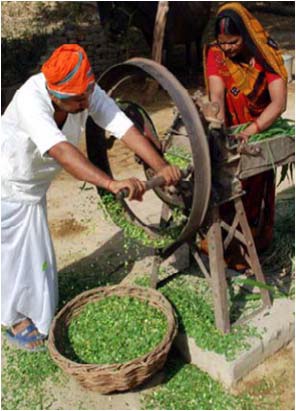
IV. REPRODUCTIVE MANAGEMENT IN BUFFALOES
Optimal reproductive efficiency is very important for profitable and sustainable buffalo production. Maximum fertility is achieved when well-managed and reproductively healthy buffaloes are bred with good-quality semen inseminated at the appropriate time and place. The reproductive efficiency varies not only between species and breeds but also among the animals within the same breed. Important reproductive characteristics of buffalo reared under sub-tropical climate are listed in the table below.
|
Sl No. |
Characteristics |
Value (Range) |
|
1 |
Sexual season |
Seasonally polyoestrous |
|
2 |
Age at puberty (months) |
21(15-36) |
|
3 |
Oestrus cycle length (Days) |
21 (18-22) |
|
4 |
Oestrus signs duration (hrs |
21 (17-24) |
|
5 |
Gestation length ( Days) |
310 (305-330) |
|
6 |
Age at first calving (months) |
42 (36-56) |
|
7 |
Calving intervals ( Months) |
18 (15-21) |
Age at puberty ranges from 16-22 to 36-40 months. Under field conditions, oestrus first occurs at the age of 24-36 months. In well-fed animals, puberty may be reached before 20 months. Puberty is significantly affected by breed, season, climate, feeding systems, growth rate. The average age at first calving lies therefore between 3 and 4 years, but many buffalo cows do not calve until much later. The female is active from July until the end of February. The peak of first matings occurs during autumn and winter. The calving interval of buffaloes varies between 400 and 600 days, although longer calving intervals are no exception. Seasonal, nutritional and managerial factors play an important role. The first oestrus is detected after 130 days post-partum in suckled animals, but may be delayed much longer depending on nutritional and climate conditions.
Reproductive efficiency is the primary factor affecting productivity and is hampered, in female buffalo, by the late attainment of puberty, seasonality of calving, long postpartum anoestrus and subsequent calving interval. Proper oestrus management allows for more efficient planning of milk production, especially in larger herds and facilitates the use of artificial insemination. Essentially similar basic approaches are being used in buffaloes as there are in cattle. All of the pharmacological systems for oestrus management used nowadays in buffaloes have been adapted from the systems used in cattle through empirical approach and are supported with increasing number of controlled works reported in the literature.
Heat detection in buffaloes
Successful artificial insemination depends on depositing the semen in the female tract at suitable time during the estrus or heat period. Estrus period is the period of sexual receptivity of female to an active male animal. It is advisable to regularly observe animals twice daily preferably in early morning and late evening for important estrus signs. 60-70 % of the buffalo come in heat from 6 pm to 6 am (after sunset and before sunrise) and this should be borne in mind and attendant should watch the buffaloes in the evening and early morning for expression of heat symptom.
Buffalo oestrus behaviour is less intense than that of cows and is consequently much more difficult to detect. Unlike in the cattle, copious ropy hanging discharge is not seen on the contrary it gets suddenly dropped and is not noticed by the owner and the discharge is scanty. Swollen reddish vulva, mounting behaviour (far less frequent than in cattle) and the standing reflex are some signs of oestrus. Some buffaloes do not bellow and show silent heat, especially high yielding buffaloes. Some buffaloes in heat remain restless, off feed, raising head in a typical fashion. Teaser bull (vasectomised bull) can be used for parading in buffalo sheds for detection of heat.
Artificial Insemination (A.I.) in buffaloes
A.I. is a reproductive technology by which semen is collected from the superior male and introduced into a receptive female reproductive tract with the artificial means at proper time and under most hygienic conditions. It is a powerful tool mostly employed for rapid genetic gain and livestock improvement. In A.I, the germplasm of buffalo bulls of superior quality can be effectively utilized with the least regard for their location in far-away places. Major advantages of AI over natural mating in buffaloes include:
-
Rapid genetic gain is achieved through extensive use of semen from genetically superior buffalo bull
-
A.I. make selective breeding easier as semen from a proven bull can be easily transported to distant places and can be used for insemination on a large scale
-
Eliminates the cost of maintenance of breeding bull & breeding cost
-
It minimizes spread of sexually transmitted diseases
-
The progeny testing can be done at an early age
-
Mating of buffaloes of different sizes is possible through A.I.
-
It helps in maintaining the accurate breeding records.
The process of A.I. and semen handling requires specialized equipments and accessories. The basic equipments and materials include A.I gun, sterile sheaths, thawing unit or warm water, frozen semen container with semen straws, forceps, scissors, thermometer, disposable gloves, apron, paper towels, cotton. It is important to keep insemination equipments and accessories clean, dry and ready at all times.
Since estrus or heat may last from 10 to 25 hours there is considerable space in possible time of A.I. Maximal conception is obtained when cows are inseminated between mid-estrus and the end of standing estrus, with good results up to 6 hours after estrus. AI success rate is lower when cows are bred prior to mid-estrus or later than 6 hours after end of estrus. A successful heat detection program and subsequent proper timing of A.I. will pay dividends in increasing reproductive efficiency.
A practical recommendation for timing of A.I.
|
Animals showing estrus |
Should be inseminated |
Too late for good results |
|
In morning |
Same day evening |
Next day |
|
In afternoon |
Next day morning or early afternoon |
Next day afternoon |
Care of Pregnant Animals
-
Animals in the last trimester of pregnancy should not be taken far away for grazing
-
Lactating animal should be dried within a period of 15 days after 7th month of gestation.
-
Pregnant animals should have enough space for standing and sitting comfortably.
-
Pregnant animals need suitable ration to reduce the possibility of diseases like milk fever and ketosis at the time of calving and also to ensure adequate milk production.
-
Water should be provided round the clock to pregnant animals with a minimum of 75-80 litres of fresh and clean drinking water daily.
-
4-5 days before calving, animal should be tied in a separate clean and airy area having sunlight. Bedding materials like paddy straw should be spread on the ground.
Buffalo should be dried off approximately 2 to 3 months before expected calving. The dry period is valuable to the buffalo, she may rest and the udder tissue is repaired. In a high yielding herd (above 10 kg per day) the buffalo should be dried off when the daily yield falls below 2.5 kg, even if it is still more than 3 months to expected calving. This goes especially for machine milked herds. An alternative to drying off is to use the buffalo as a foster mother to newly born calves.
Calving difficulty (dystocia) is directly associated with a decreased number of calves weaned, due to increased calf and cow mortality. Furthermore, dystocia also has an indirect role in many cases of calf mortality attributed to infectious disease, and in the dam, it suppresses reproductive performance (prolongs the postpartum interval and reduces the conception rate). Farmers should carefully consider all factors like nutrition, climate, selection of sire etc. that influence birth weight to reduce calving difficulties, particularly for first-calf heifers. Nutritional management during pregnancy may affect the incidence of dystocia which increases as cows tend to be weaker. Warmer environments and forced exercise reduce the incidence of dystocia in confinement-raised or stall-fed heifers.
Calf Management
The success of any dairy enterprise depends on the production of sufficient calves to act as the replacement stock. Important aspects in the calf rearing are the health and nutrition management. Calf mortality was associated with the type of housing, feeding, managemental practices, weather conditions, external and internal parasitic problems and bacterial infections especially those causing septicaemia and enteritis. The first month of the buffalo calf's life is very crucial and it is found that the calf mortality is as high.
-
The mother should be allowed to lick the newborn; if the dam fails to lick it can be stimulated by sprinkling small quantity of salt or bran over the young one.
-
Immediately after birth, the naval cord should be ligated with clean sterile cotton thread one inch from the body and tincture iodine should be applied to the naval cord.
-
Within 1 hour after birth, the newborn will able to stand and it should be allowed to drink adequate quantity of colostrum (first milk) which will give immunity to the newborn.
-
In winter condition adequate warmth condition should be provided.
-
Adequate bedding materials like straw or hay should be provided to newborn animals.
Major reproductive disorders and their management
1. Anestrus: Anestrus or failure to show signs of estrus is an important reproductive disorder. Important reasons include genetic causes, failure to detect oestrus signs, subestrus, weak or silent oestrus, low plane of nutrition- lack of energy and protein, deficiency of minerals, Anoestrus can also be due to uterine pathology such as pyometra, mummified foetus, foetal maceration and insufficient hormonal stimuli. Silent, weak or subestrus are most common in buffaloes and requires rectal examination and treatment by qualified veterinary doctor.
-
For anestrus due to weak body condition, deworming should be carried out and extra feeding of concentrate mixture or grains with adequate amount of green fodder and other roughages, mineral mixture should be properly supplemented.
-
Anestrus cases involving uterine pathology and hormonal stimuli should be handled by qualified veterinary practitioner.
-
Unobserved oestrum may be due to managerial deficiencies and short period of oestrus. The dairy animals should be observed for heat signs at least three times a day.
2. Repeat breeding: Animals come to heat and not conceived after three successive inseminations are called repeat breeder. Causes include hormonal imbalance, delayed ovulation or failure of ovulation, defective ovum or ageing of ovum or sperm may leads to fertilization failure, infections, nutritional deficiency of selenium and Vitamin E, environmental stress leading to early embryonic death. Prevention and management
-
Balanced nutrition and adequate mineral mixture supplementation to breeding stock
-
Ensure proper timing and technique of A.I. twice at each oestrus
-
Skipping of AI and intrauterine infusions may be considered for uterine pathology.
-
Diseased bulls should not be allowed for breeding.
-
Hormonal therapy in case of delayed ovulation cases.
3. Endometritis: Endometritis is a localized inflammation of the uterine lining, associated with chronic postpartum infection of the uterus with pathogenic bacteria. Causes include pathogens usually reach the uterus at the time of mating, insemination, parturition or postpartum. In animals that develop endometritis, the bacterial flora is not eliminated from the uterus, causing the endometrium to become inflamed. Some of the factors associated are, retained fetal membranes, abortion, induced calving, multiple births and dystocia. Symptoms include presence of whitish-yellow mucopurulent vaginal discharge. Volume of discharge is variable, but frequently increases at the time of oestrus. The cows rarely show any signs of systemic illness, although in a few cases milk yield and appetite may be slightly reduced. A wide range of antibiotics, hormones, antiseptics and immunomodulators have been used as treatments for endometritis.
4. Uterine Prolapse: This is expulsion of uterine mass through the vagina. It is a common complication of third stage of labour. It is more common in pluriparous than primiparous animals. Signs include mild protrusion of vaginal mucous membrane through the vulval lips, usually protruded mass is covered with faeces, straw, dirt or blood clots.Stress, restlessness, pain, anxiety, increased respiratory rate may be noticed. Pale mucus membrane, expiratory grunt and prostration with severe depression. Prevention and management
-
The mass should be protected from contamination from out sources. The mass should be covered with wet clean clothes until treatment. It needs careful insertion of protruded uterine mass into the body and suturing the in the vulval lips.
5. Uterine Torsion: It is the twisting or revolution of the gravid uterus on its long axis and is common in cows and buffaloes. Higher incidence observed among pluriparous than primiparous animals. Clinical signs include abdominal pain, anorexia, constipation, lack of ruminations, restlessness or colic symptoms, teeth grinding, treading and tail switching, displacement of dorsal commissure, Tucked up udder and vulval edema. Prevention and management
-
Pregnant animals should be housed separately and extra care should be given in handling the animals.
-
Rolling, frequent lie down and falling of pregnant animals should be avoided
-
This condition must be handled with qualified veterinary doctor.
-
Rotation/ rolling of the dam may be performed with the help of veterinary doctor.
-
In complicated cases cesarean or Laparo- hysterotomy may be recommended.
6. Retention of fetal membranes: One of the most common conditions occurring in animals following parturition. This is failure of the villi of the fetal cotyledon to detach from the maternal crypts of caruncles and retained longer than normal time limits. If the placenta is retained longer than 8-12 hours, the condition is considered as pathological. Lack of exercise, low vitamin-A level in feed and infections like brucellosis can contribute to incidence. A portion of the fetal membranes may hang from vulva 12 hours or more even after the expulsion of the foetus. Anorexia and depression may develop. Prevention and management
-
The protruding membranes should be tied in a knot to prevent them touching hocks.
-
Manual removal can be attempted in 24- 48 hours after parturition provided placenta is coming freely. forcible removal will cause small lesions to the uterus.
-
Manual removal is not advisable after 48 hours because cervix will be closed and also in cows with elevated temperature and also with vaginitis and vulvitis
-
Pharmaceutical interventions using prostaglandin, collaginase enzyme, Intravenous calcium, intrauterine oxytetracycline
-
Supplementation of vitamin E selenium in nutrient deficient cows reduces incidence
General points for optimal reproductive management in buffaloes:
-
Buffaloes should be observed for heat signs at least two times a day and artificially bred at right time
-
Unobserved oestrus may be due to managerial deficiencies and short period of oestrus
-
Silent / weak / Suboestrus are most common in buffaloes and common in post-partum period. In this, cyclical changes in the genital organs occurs but the signs of heat are not exhibited or not observed
-
Animals that do not show oestrus or do not come to cycle should be checked and treated.
-
Wall charts, breeding wheels, herd monitors and individual records may be used for proper breeding record keeping
-
Animal should be fed with a well-balanced diet with energy, protein, minerals and vitamin supplements. This helps in increased conception rate, healthy pregnancy, safe parturition, low incidence of infections and a healthy calf.
-
Regular vaccination and deworming should be done to maintain health status of animals.
-
After 45-60 days of A.I., animals should be checked for pregnancy
-
Pregnant buffalo should be housed away from the general herd for better feeding management and parturition care.
-
Unwarranted stress and transportation should be avoided during the last stages of pregnancy.
-
Breeding can be started within four months or 120 days after delivery to achieve the goal of one calf per year for economic and profitable dairy farming, according to them.
-
Care of young female calves with good nutrition helps them to attain timely puberty with an optimum body weight of 230-250 kg, suitable for breeding and thereby early conception.
V. BUFFALO HERD HEALTH MANAGEMENT
Herd health management is an important component of scientific livestock rearing. Proper disease control and timely treatment are prerequisite for optimal farm productivity. The most basic method of disease control in individual herds is to avoid introduction of disease agents. If possible and practical, farmers should keep a closed herd. Most diseases of contagious nature are introduced into operations when new animals are added. Advice and treatment from a veterinarian is almost an absolute in preventing and controlling health problems in a herd. Vets can recommend vaccination programs; help with parasite control programs; assist in reproductive management; deal with emergency situations; do necropsies on dead animals; and perform a host of other important management tasks. Identification of animals in the early stages of sickness can aid the farm manager in restricting the spread of disease in the flock and initiating treatment at the earliest. For a farmer or a herd manager, it is always advantageous to gain basic knowledge about common diseases affecting buffaloes.
Common diseases in buffaloes and their control
Black Quarter: It is an acute infection but a non-contagious disease characterized by inflammation of muscles, severe toxaemia and high mortality in farm animals. Buffaloes usually suffer a mild disease. The outbreaks occur with the onset of rainy season. The most obvious sign in a crepitate swelling in hind- or forequarters crackles when rubbed due to gas in the muscle. The symptoms are fever, lameness and switching of the muscles of the affected region. The affected region is hot and painful but soon becomes cold and painless, and there is crepitation due to gas. The skin over the affected area becomes dry, hard and dark. Penicillin and tetracycline’s if given promptly and inoculated into the site of lesion are of value and should be given in normal therapeutic dose. Sulphathiozole and antitoxicsera also effective. Hygiene and prophylaxis are the methods of control. Active immunization of animals before the onset of rainy season has proved to be effective.
Haemorrhagic Septicaemia (HS): It is an actual infectious disease of cattle, buffalo, sheep and goat caused by Pasteurella multocida. Etiology environmental conditions, malnutrition and long distance transportation. Transmission is through ingestion of contaminated feed and water and through inhalation. Signs include high fever, loss of appetite, dullness and depression, rapid pulse and heart rate, profuse salivation, nasal discharge, difficult/snoring respiration and swelling of throat region. Proper disposal of contaminated feed and water and disinfection of cattle shed is recommended. Avoid long distance transportation and exposure to extreme weather. Vaccination should be given through subcutaneous route every year before monsoon.
Tuberculosis (TB): It is a chronic infectious disease of humans, livestock and wildlife. It is an important disease in cattle, buffaloes, pigs. The germs causing the disease form tubercles or nodules which are found in many organs and especially in the lungs. As the nodules increase in size the organs cannot function and the animal will die. Tuberculosis of the lungs causes a harsh, dry cough. After a period of time the animal begins to cough up yellowish-white sputum. The tuberculin test is used to check if an animal is infected with TB. It is advisable to boil milk from animals before drinking it. Good hygiene, good feeding and good ventilation of any animal houses will prevent the disease from occurring.
Johne’s disease or Paratuberculosis: It is a specific chronic contagious enteritis of cattle, buffaloes and goat. The disease is characterized by progressive emaciation and in buffaloes by chronic diarrhoea and thickening of the intestine. Under natural conditions, disease spread by ingestion of feed and water contaminated by the faeces of infected animals. The animal aged 3 to 6 years mostly suffer from the disease. Affected animals may not show clinical symptoms continue to discharge organisms in faeces. The affected animal should be segregated and their faeces properly disposed off. Vaccines with live strains have been developed and is generally done in heavily infected herds.
Bovine ephemeral fever: It is an insect-transmitted, non-contagious, viral disease of cattle and buffalo. Signs, which occur suddenly and vary in severity, can include biphasic to polyphasic fever, shivering, inappetence, lacrimation, serous nasal discharge, drooling, stiffness and lameness, and sudden decrease in milk yield. Clinical signs are generally milder in buffaloes. Complete rest is the most effective treatment, and recovering animals should not be stressed or worked because relapse is likely. Anti-inflammatory drugs given early and in repeated doses for 2-3 days are effective. Antibiotic treatment to control secondary infection and rehydration with isotonic fluids may be warranted.
Buffalo-Pox: This disease occurs in buffaloes in both generalized and localized forms in udder, inner thigh, lips and nostrils. Since buffaloes wallow in marshy places care should be taken to see that the wounds are cleaned well and kept free form files. After an incubation period of 2 to 5 days, there is rise in body temperature; animal develops pin-point red spots and papules of the size of mustard which later coalesce into vesicles. The lesions can be cleaned with 1:1,000 solution of potassium permanganate followed by application of antiseptic ointment such as 1:110 boric acid. The affected animals should be isolated and milked by separate milkers.
Veterinary vaccines play a key role in herd health management. Apart from improving animal health and productivity, veterinary vaccines have a significant impact on public health through reductions in the use of veterinary pharmaceuticals and hormones and their residues in the human food chain. Schedule of common vaccinations in buffaloes is described in the below table.
Schedule for vaccination in buffaloes
|
Sl No. |
Disease |
Type of vaccine |
First dose & booster dose |
Duration of immunity |
Remarks |
|
1 |
Anthrax (Gorhi) |
Spore vaccine |
4 months & above. Yearly pre-monsoon vaccination |
One season |
Annually in endemic areas |
|
2 |
Black Quarter (Sujab) |
Killed vaccine |
6 months & above. yearly pre-monsoon vaccination |
One season |
Annually in endemic areas |
|
3 |
Haemorrhagic Septicaemia (Galghotu) |
Oil adjuvant vaccine |
6 months & above. yearly pre-monsoon vaccination |
One season |
Annually in endemic areas |
|
4 |
Brucellosis (Contagious abortion) |
Cotton strain 19 (live) |
4-8 months of age |
3 or 4 calvings |
To be done only in infected herds |
|
5 |
Foot and Mouth disease (Muhkhar) |
Polyvalent tissue culture |
At about 6 months of age with booster dose 4 months later |
One season |
Repeat 2-3 times in every year |
Deworming: Deworming to remove endoparasites should be started from the first week of calf. A single oral dose of 10 g piperazine adepate is recommended for the calves preferably in the first week of life to control neonatal ascariasis especially in buffalo calves. Deworming should be done every month for first 6 months, thereafter once in three months. The deworming drugs and dose should be consulted with qualified veterinary doctor. Over dose and under dose of deworming drugs should be prevented to check the side effects.
Cleaning of animal sheds: Easy and quick method of cleaning animal sheds is with liberal use of tap water, proper lifting and disposal of dung and used straw bedding, providing drainage for complete removal of liquid waste and urine. The daily removal of feed and fodder left over in the manger, reduces fly menace. Periodical cleaning of water trough eliminates growth of algae, bacterial and viral contamination. Sanitation is necessary in the buffalo sheds for eliminations of all microorganisms that are capable of causing disease in the buffaloes. Dry floorings keeps the houses dry and protects from foot injury. Similarly, presence of flies and other insects in the dairy farm area are also adds to the welfare and health problems of the herd. Disinfection of animal sheds means making these free from disease producing bacteria and is mainly carried out by sprinkling chemical agents such as bleaching powder, 1-2% Iodine and lodophor, 4% sodium carbonate solution, washing soda, slaked lime (Calcium hydroxide), quick lime (Calcium oxide) and phenol.
Record keeping: The complicated job of management of a dairy buffalo herd requires sound planning. It requires day to day planning, coordination, execution and evaluation and is possible only when the farmer or manager has all the facts pertaining to the stock before him. Such facts can be obtained from production and reproduction records. Some of the important registers or records include: daily stock register, Birth/calving register, Calf / young/adult stock register, Breeding register/ AI register, milk yield and distribution register, sales/ disposal register, mortality register, Feed stock register, Herd health register, Receipt/ Income register. Uses of proper record keeping:
-
Each animal in the herd is identified with respect to their production performance.
-
Close management and appropriate feeding levels can be provided
-
Efficiency of culling and selection has been increased which in turn will increase profit rate.
-
Livestock marketing can be promoted on the basis of performance records.
-
Superior stock can be identified for extensive use in breeding programmes.
Guidelines for good management practices in buffalo farming
-
Providing the right type of housing for buffalo to fit their natural behavioural requirements is key to their optimum performance. Free stall-fed and semi-intensive systems work well provided housing delivers sufficient shelter from both heat and extreme cold.
-
Showers or foggers with fans or wallowing tanks should be made available to buffalo during the hottest part of the day. Thermal ameliorative measures such as sprinkling and cooling/showering are known to increase comfort levels and feed intake in buffaloes.
-
Balanced feeding with mineral supplements, plenty of green fodder, and concentrate as per each animal’s specific need, is necessary to bring buffalo into normal reproductive cycles.
-
Controlling the animals' intake of feed is a good practice. Low yielders tend to eat more than they require and at the same time it is difficult for the high yielders to eat enough. It is therefore vital that the feed is analyzed and the milk yield known, in order to provide the correct nutrient requirement for each animal.
-
Cool water either from a clean river or served in an earthen pit, helps the animals to maintain their temperature. Drinking bowls are used extensively for buffalo as an efficient way to provide clean, cool, fresh water at all times. Water troughs should always be placed in the shade.
-
In hot humid climates, shed walls may lead to inadequate ventilation, favouring bacteria and mould growth which makes the stable unhygienic. To protect the interior from sunshine (or heavy rain), curtains made from straw, textile or other suitable material can be used.
-
Regular twice daily heat detection and early pregnancy diagnosis are important for optimal reproductive management of the herd.
-
Wall charts, breeding wheels and individual animal records are important for record keeping. The key to successful use of these inexpensive management aids is to accurately record every heat, beginning with the first heat after calving, and to make daily use of the information to identify those buffalo that are due to return to oestrus.
-
Regular testing for infectious reproductive diseases like brucellosis and regular culling of infected animals are crucial for good reproductive health in the buffalo herd. Attending cases of difficult birth and retained placenta in time and maintaining good hygiene during parturition are also crucial to prevent reproductive disorders such as endometritis.
Sources:
1. Agri-IS 2.0 (2019). Information System on Animal Genetic Resources of India-Agri-IS information system, ICAR- National Bureau of Animal Genetic Resources
2. Agritech portal of TNAU
3. http://www.buffalopedia.cirb.res.in/
4. Gokuldas. PP and Chakurkar E.B. (2017). Training on AI in dairy animals, ICAR-CCARI, Goa.
5. http://agritech.tnau.ac.in/animal_husbandry/animhus_buffalo%20breeds.html
6. http://www.nddb.org/farmer/animal-nutrition/feeding-of-dairy-animals
7. The South Asia Pro Poor Livestock Policy Programme (SA PPLPP)
